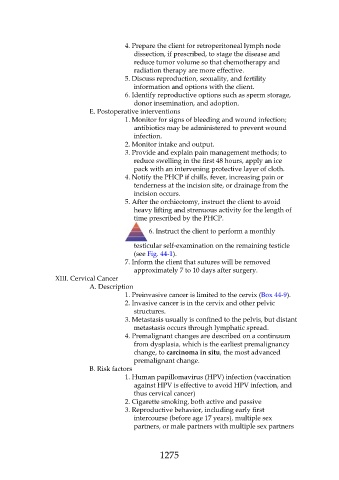Page 1275 - Saunders Comprehensive Review For NCLEX-RN
P. 1275
4. Prepare the client for retroperitoneal lymph node
dissection, if prescribed, to stage the disease and
reduce tumor volume so that chemotherapy and
radiation therapy are more effective.
5. Discuss reproduction, sexuality, and fertility
information and options with the client.
6. Identify reproductive options such as sperm storage,
donor insemination, and adoption.
E. Postoperative interventions
1. Monitor for signs of bleeding and wound infection;
antibiotics may be administered to prevent wound
infection.
2. Monitor intake and output.
3. Provide and explain pain management methods; to
reduce swelling in the first 48 hours, apply an ice
pack with an intervening protective layer of cloth.
4. Notify the PHCP if chills, fever, increasing pain or
tenderness at the incision site, or drainage from the
incision occurs.
5. After the orchiectomy, instruct the client to avoid
heavy lifting and strenuous activity for the length of
time prescribed by the PHCP.
6. Instruct the client to perform a monthly
testicular self-examination on the remaining testicle
(see Fig. 44-1).
7. Inform the client that sutures will be removed
approximately 7 to 10 days after surgery.
XIII. Cervical Cancer
A. Description
1. Preinvasive cancer is limited to the cervix (Box 44-9).
2. Invasive cancer is in the cervix and other pelvic
structures.
3. Metastasis usually is confined to the pelvis, but distant
metastasis occurs through lymphatic spread.
4. Premalignant changes are described on a continuum
from dysplasia, which is the earliest premalignancy
change, to carcinoma in situ, the most advanced
premalignant change.
B. Risk factors
1. Human papillomavirus (HPV) infection (vaccination
against HPV is effective to avoid HPV infection, and
thus cervical cancer)
2. Cigarette smoking, both active and passive
3. Reproductive behavior, including early first
intercourse (before age 17 years), multiple sex
partners, or male partners with multiple sex partners
1275

